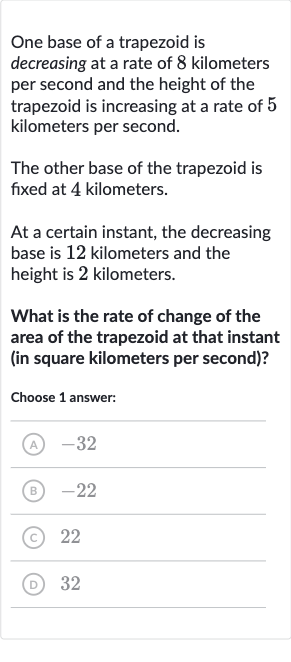AI tutor
Welcome to Bytelearn!
Let’s check out your problem:

One base of a trapezoid is decreasing at a rate of kilometers per second and the height of the trapezoid is increasing at a rate of kilometers per second.The other base of the trapezoid is fixed at kilometers.At a certain instant, the decreasing base is kilometers and the height is kilometers.What is the rate of change of the area of the trapezoid at that instant (in square kilometers per second)?Choose answer:(A) (B) (C) (D)
Full solution
Q. One base of a trapezoid is decreasing at a rate of kilometers per second and the height of the trapezoid is increasing at a rate of kilometers per second.The other base of the trapezoid is fixed at kilometers.At a certain instant, the decreasing base is kilometers and the height is kilometers.What is the rate of change of the area of the trapezoid at that instant (in square kilometers per second)?Choose answer:(A) (B) (C) (D)
- Write Formula: First, let's write down the formula for the area of a trapezoid, which is , where and are the lengths of the two bases and is the height.
- Plug in Values: Now, we plug in the values we know. At the instant we're considering, is decreasing and is , is fixed at , and is increasing and is .
- Differentiate Area Formula: To find the rate of change of the area, we need to differentiate the area formula with respect to time . So, .
- Substitute Rates: We know (since is decreasing), (since is fixed), and .
- Calculate Result: Substitute these rates into the differentiation formula: .
- Simplify Equation: Now, let's do the math: .
- Simplify Equation: Now, let's do the math: . Simplify the equation: .
More problems from Interpret confidence intervals for population means
QuestionGet tutor help
QuestionGet tutor help
QuestionGet tutor help
QuestionGet tutor help
QuestionGet tutor help
QuestionGet tutor help
QuestionGet tutor help
QuestionGet tutor help
QuestionGet tutor help
QuestionGet tutor help
